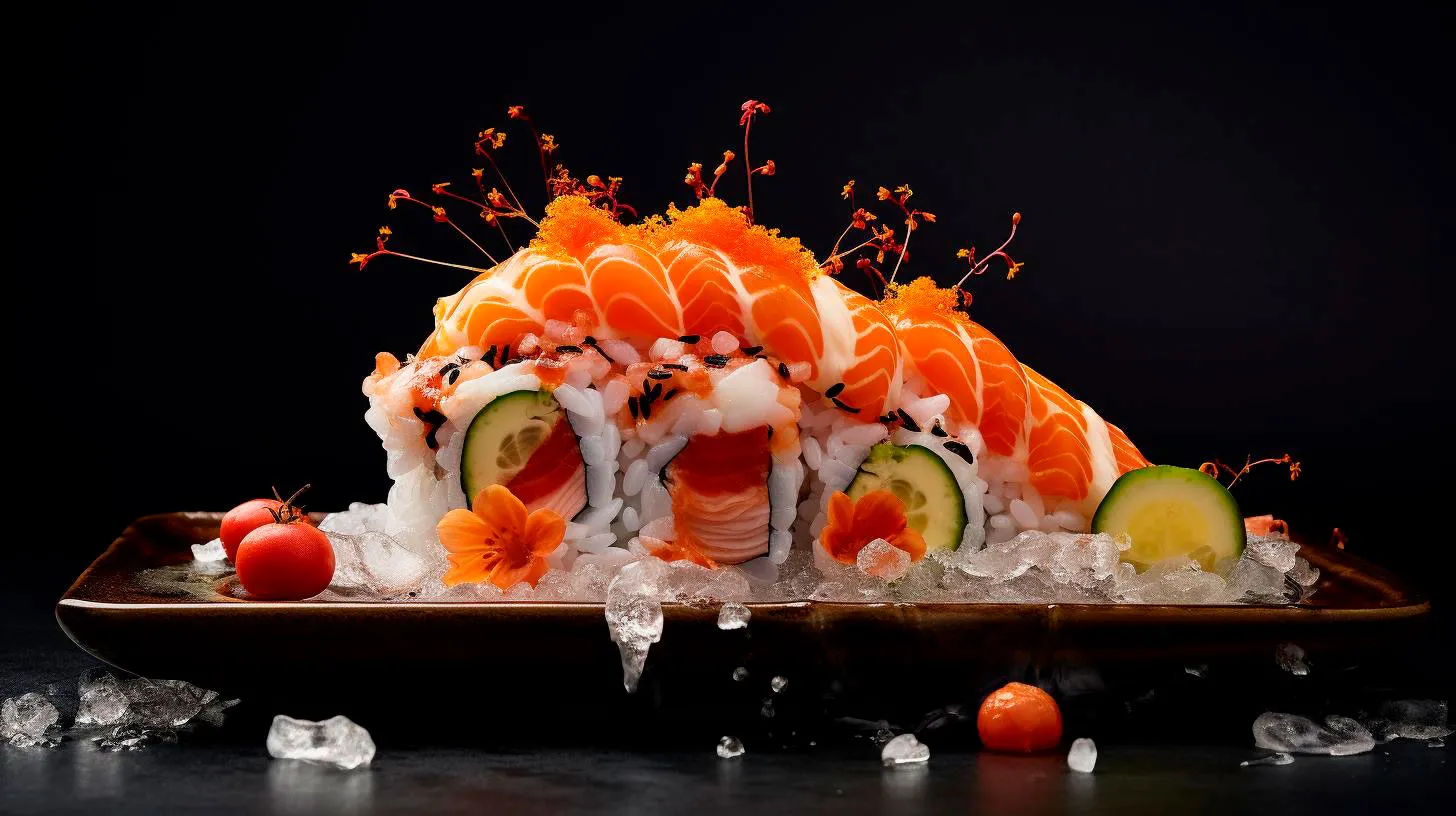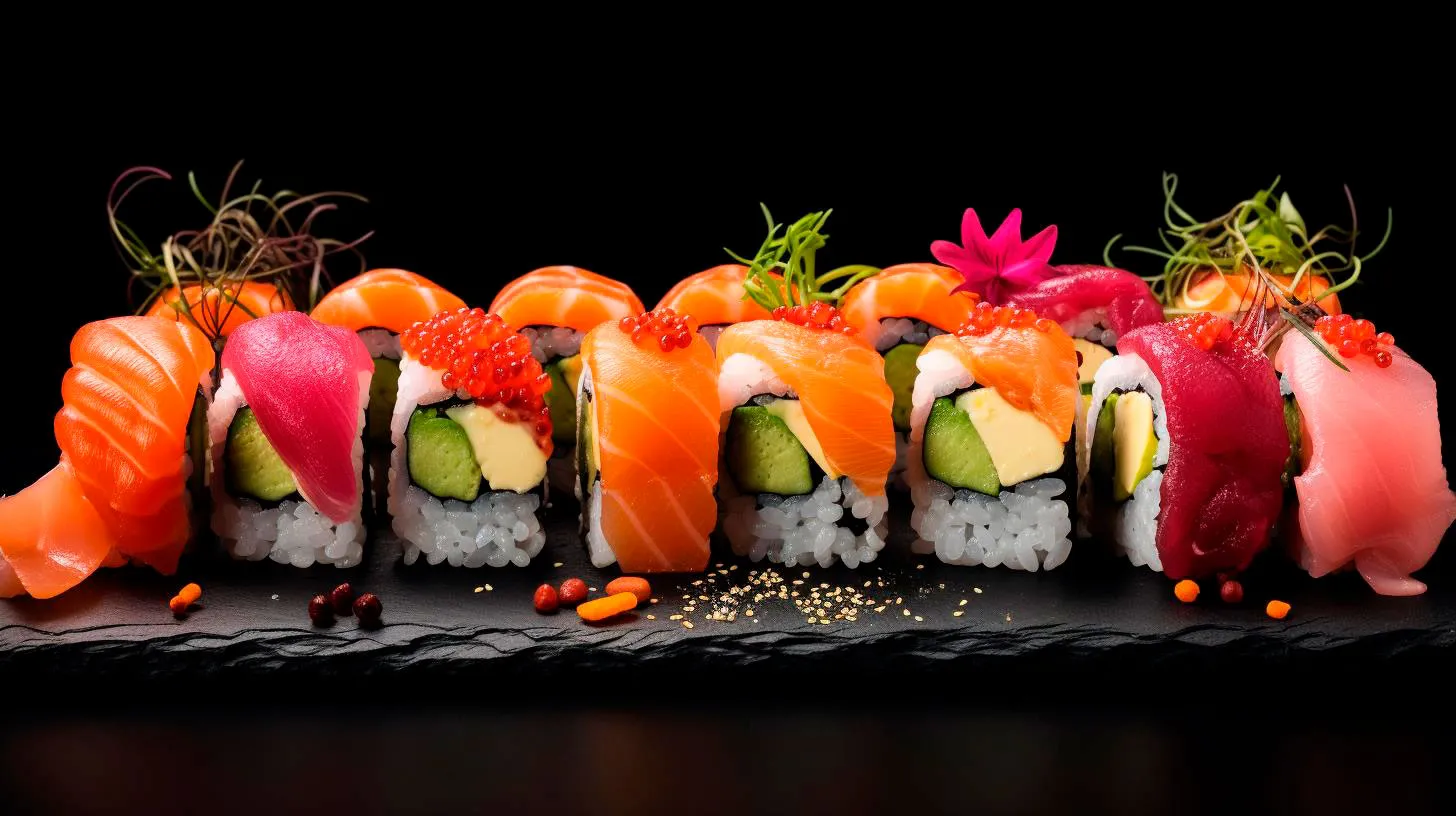The Art of Umami: Unlocking the Flavors of Sushi
In this article, we will dive into the art of umami in sushi, exploring its origins, the science behind it, and how it enhances the overall dining experience.
The Origins of Umami
The concept of umami dates back to 1908 when Japanese chemist Kikunae Ikeda identified and named it as the fifth basic taste, alongside sweet, salty, sour, and bitter. Derived from the Japanese word “umai,” meaning delicious, umami is often described as a savory, meaty, or brothy taste.
Umami is primarily attributed to the presence of glutamate, an amino acid that occurs naturally in certain foods. While glutamate can be found in a variety of ingredients, it is particularly concentrated in foods such as tomatoes, mushrooms, aged cheeses, and soy sauce. These umami-rich ingredients play a crucial role in the creation of sushi, elevating the flavors to new heights.
The Science Behind Umami
Understanding the science behind umami helps us appreciate its role in enhancing the flavors of sushi. When glutamate binds with specific taste receptors on our tongues, it triggers a pleasurable sensation that intensifies the overall taste experience. These taste receptors, known as umami receptors, recognize the presence of glutamate and other compounds responsible for the umami taste.
Additionally, inosinate and guanylate, two other compounds commonly found in sushi ingredients such as fish and seaweed, complement glutamate to heighten umami flavors. This combination of umami compounds creates a symphony of taste that makes sushi a truly delectable experience.
The Umami Journey in Sushi
Now that we have grasped the concept of umami, let’s embark on a sushi journey to explore how umami is meticulously incorporated into various sushi components:
1. Rice:
- Sushi rice, seasoned with a mixture of vinegar, sugar, and salt, creates a balanced and slightly tangy base for sushi.
- The vinegar used in sushi rice stimulates the umami taste buds, amplifying the overall umami experience.
2. Fish:
- Fresh, top-quality fish is a crucial element in sushi, providing the main source of umami.
- Fish such as tuna, salmon, and mackerel are highly prized for their rich umami flavors.
3. Soy Sauce:
- Soy sauce, a staple condiment in sushi, is fermented and aged, resulting in a complex flavor profile that complements the umami in the fish.
- Dipping a piece of sushi into a small amount of soy sauce enhances the umami experience without overpowering the delicate flavors.
4. Seaweed:
- Nori, the seaweed used to wrap sushi rolls, is an umami powerhouse, providing a distinct savory taste.
- This edible seaweed not only enhances the umami experience but also offers a satisfying textural contrast.
The Benefits of Umami in Sushi
Beyond the delightful taste experience, incorporating umami in sushi offers several key benefits:
1. Healthy Alternative:
- Umami-rich ingredients like fish, mushrooms, and seaweed are low in calories and offer essential nutrients, making sushi a healthy dining choice.
2. Flavor Enhancement:
- The umami taste elevates the flavors of sushi, providing a more satisfying and fulfilling culinary experience.
3. Umami Pairings:
- Umami can be skillfully paired with other tastes, such as sweet or sour, to create a harmonious balance of flavors in sushi.
- For example, combining umami-rich fish with subtly sweet mango or tangy pickled ginger adds depth and complexity to each bite.
Key Takeaways
As you indulge in the artful world of sushi, keep these key takeaways in mind:
- Umami is the fifth basic taste, providing a savory and pleasurable experience in sushi.
- Glutamate, inosinate, and guanylate are the primary compounds responsible for umami.
- Umami is present in various sushi components like rice, fish, soy sauce, and seaweed, enhancing the overall taste and enjoyment.
- Incorporating umami-rich ingredients in sushi not only offers a flavorful experience but also provides several health benefits.
- Pairing umami with other tastes can create a harmonious balance, taking your sushi experience to new heights.
Next time you savor a piece of sushi, take a moment to appreciate the delicate dance of umami on your palate. The artful combination of flavors and textures in sushi truly showcases the wonders of umami, making it an extraordinary culinary experience.
Savory Symphony: How Sushi Chefs Balance Tastes
In this article, we dive into the world of sushi and explore how chefs create a savory symphony on each plate.
Taste Balance: The Essence of Sushi
When we savor a sushi roll, we experience a harmonious blend of tastes that awakens our senses. This balance of flavors is no coincidence; it is a result of the meticulous craftsmanship of sushi chefs. Let’s explore the key elements that contribute to this savory symphony:
1. Umami – The Fifth Taste
While most of us are familiar with sweet, sour, bitter, and salty, umami is the fifth taste that Japanese cuisine has long celebrated. It is often described as a savory or meaty flavor that adds depth and richness to dishes. Sushi chefs harness umami by using ingredients like soy sauce, seaweed, and fish broths, amplifying the overall taste experience.
2. Precise Rice Preparation
Rice, the foundation of any sushi roll, plays a crucial role in taste balance. It should be perfectly cooked, seasoned with vinegar, salt, and sugar, to provide a delicate balance of flavors. Chefs take great care in achieving the ideal texture and taste of the rice, ensuring it complements the fish and other ingredients seamlessly.
3. Freshness and Quality of Fish
The quality and freshness of fish are paramount in sushi preparation. Sushi chefs work closely with suppliers to source the finest and freshest fish available. By carefully selecting fish that is in season and obtaining it from reputable sources, they guarantee the best flavors and textures for their sushi creations.
The Art of Symphonic Sushi Creation
Sushi chefs don’t just focus on taste balance; they also pay attention to visual appeal, texture, and even temperature. Here’s how they create a memorable sushi experience for diners:
1. Nigiri: Meticulous Hand Crafting
Nigiri, the most iconic sushi style, showcases the chef’s expertise in creating perfectly seasoned rice and pairing it with fresh fish slices. The chef’s hands play a crucial role in forming the sushi rice into a compact mound, ensuring the right balance of rice and fish in each bite.
2. Maki: Beautiful Bundles
Maki rolls provide chefs with an opportunity to experiment with a variety of flavors and textures. They carefully layer ingredients such as fish, vegetables, and sauces, creating stunning culinary compositions. The visual presentation makes the dining experience even more exciting and enjoyable.
3. Temperature Play: Hot and Cold
Sushi chefs skillfully introduce contrasts in temperature to enhance the overall taste experience. For instance, they might serve a warm tempura roll alongside a refreshing, chilled tuna roll. This interplay of temperatures adds depth to the symphony of flavors and keeps our taste buds guessing.
Key Takeaways
Sushi is not just about raw fish and rice; it is an art form that delights our palate and engages our senses. Here are the key takeaways to remember:
- Sushi chefs create a delicate balance of tastes through the umami flavor, precise rice preparation, and quality ingredients.
- Freshness and seasonality of fish are crucial in delivering an exceptional sushi experience.
- Nigiri and maki offer unique techniques for chefs to showcase their craftsmanship and creativity.
- Contrasting temperatures add depth and excitement to the symphony of flavors in sushi.
Next time you indulge in a sushi feast, appreciate the extraordinary skill and attention to detail that sushi chefs put into their creations. It is through their mastery that we can experience the harmonious balance of flavors in every bite.
Taste Transcends Words: Exploring the Silent Communication of Sushi Chefs
But beyond the visual appeal and exquisite flavors, there’s another element that adds a touch of magic to this Japanese delicacy – the silent communication between sushi chefs and their patrons.
The Sushi Chef’s Canvas
Just like a painter creating a masterpiece on a blank canvas, a sushi chef starts with a clean slate – a perfectly formed ball of rice. With a few swift and subtle movements, the chef shapes the rice into a delicate foundation for the sushi. Each grain is carefully placed and balanced, reflecting the chef’s attention to detail and commitment to perfection.
The main ingredient, whether it’s a succulent slice of fish, a creamy slice of avocado, or a vibrant medley of vegetables, is then added to the rice bed. The chef’s choice of ingredients depends on the season, freshness, and overall harmony of flavors. The selection process requires deep knowledge and an understanding of how each element will interact and enhance the dish.
As the chef begins to construct the sushi, there’s a sense of focused intensity in the way they wield their knife. Every cut is precise, ensuring the perfect balance of texture and taste. Whether it’s a clean slice or a decorative incision, the chef uses their knife as an extension of their artistic expression.
The Language of Ready-to-Serve Sushi
Once the sushi is ready, it’s presented to the patron with the utmost care. The chef’s silent communication takes center stage, as they convey information about the dish through its appearance and arrangement. This non-verbal language speaks volumes and sets the stage for the gastronomic journey that awaits.
The plate itself becomes a canvas for the chef’s creativity, as they arrange the sushi with precision and finesse. Each piece is positioned to highlight its unique features and enhance visual appeal. The chef’s attention to symmetry, color contrast, and overall presentation reinforces their commitment to excellence.
Moreover, the chef often adds small touches like garnishes or decorative sauces, further enhancing the overall aesthetic of the dish. These additions not only please the eye but also provide subtle hints about flavor profiles and ingredient combinations.
Key Takeaways from the Silent Communication of Sushi Chefs
- The art of sushi-making goes beyond taste and presentation.
- Sushi chefs communicate with patrons through non-verbal cues.
- Attention to detail and precision are essential in sushi creation.
- Symmetry, color, and presentation play crucial roles in the dining experience.
- Japanese cuisine values harmony and balance in taste and aesthetics.
In the world of sushi, taste transcends words. Through the silent communication of sushi chefs, patrons are invited to embark on a sensory journey that engages all the senses. From the meticulous preparation to the artful presentation, every aspect of sushi creation is a testament to the chef’s expertise and dedication.
So, the next time you indulge in a platter of sushi, take a moment to appreciate the unspoken dialogue between the chef and the plate. It’s a silent conversation that speaks volumes about the traditions, techniques, and artistry of this revered Japanese cuisine.
Giving Voice to Ingredients: Sushi as a Language
In this article, we will delve into the fascinating world of sushi, exploring how it communicates through colors, textures, and flavors.
A Visual Symphony of Colors
When it comes to sushi, presentation is key. Each carefully crafted piece is a work of art, carefully assembled to harmonize a variety of colors. These vibrant hues not only entice the eye but also convey important messages about the ingredients. For instance:
- The rich scarlet of tuna symbolizes its lusciousness and fatty content.
- Green hues in sushi highlight the freshness and crispness of ingredients such as cucumber or avocado.
- Orange colors often denote the mild sweetness of salmon or a delicate touch of spicy flavor.
Understanding the language of colors in sushi helps patrons choose their desired flavors and experiences, enhancing their enjoyment of the meal.
Textures that Speak to the Palate
Just as colors communicate, sushi uses a variety of textures to captivate the palate. By combining different ingredients, sushi chefs provide an array of tactile experiences, such as:
- The soft and buttery texture of raw fish intensifies the overall richness of the sushi piece.
- Crunchy textures, brought by ingredients like tempura or fried onions, add a delightful contrast.
- Chewy seaweed wraps create a unique mouthfeel, enhancing the overall sushi experience.
Understanding the language of textures in sushi allows diners to explore their preferences and discover new dimensions of pleasure in every bite.
A Symphony of Flavors
The language of sushi goes beyond colors and textures; it is a true symphony of flavors that invites your taste buds on a tantalizing adventure. The diverse tastes of sushi ingredients provide an extraordinary range of experiences:
- The umami flavor in sushi rice, combined with the delicately sweet and sour notes of rice vinegar, creates a well-balanced foundation.
- Spicy flavors from wasabi and the heat of ginger provide a refreshing sensation.
- Soy sauce, with its savory and salty undertones, complements and elevates the flavors of various sushi ingredients.
Understanding the language of flavors in sushi allows diners to appreciate the subtle nuances and experience the intricacies of this ancient culinary art.
Key Takeaways
Sushi, beyond being a delicious meal, is a language that speaks through its ingredients. By understanding the message behind the colors, textures, and flavors, diners can truly appreciate the art of sushi. Here are some key takeaways:
- The colors in sushi convey information about ingredients, guiding diners to their desired flavors.
- Textures play a crucial role in enhancing the overall sushi experience, offering a diverse sensory journey.
- The symphony of flavors in sushi ensures a delightful adventure for the taste buds.
Embrace the language of sushi, and let it guide you on a culinary exploration like no other!


